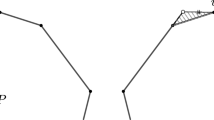Abstract
We consider the width \(X_T(\omega )\) of a convex n-gon T in the plane along the random direction \(\omega \in {\mathbb {R}}/2\pi {\mathbb {Z}}\) and study its deviation rate:
We prove that the maximum is attained if and only if T degenerates to a 2-gon. Let \(n\ge 2\) be an integer which is not a power of 2. We show that
is the minimum of \(\delta (X_T)\) among all n-gons and determine completely the shapes of T’s which attain this minimum. They are characterized as polygonal approximations of equi-Reuleaux bodies, found and studied by Reinhardt (Jahresber. Deutsch. Math. Verein. 31, 251–270 (1922)). In particular, if n is odd, then the regular n-gon is one of the minimum shapes. When n is even, we see that regular n-gon is far from optimal. We also observe an unexpected property of the deviation rate on the truncation of the regular triangle.







Similar content being viewed by others
Notes
In literature, it is often referred to as a “Reuleaux polygon”, though its boundary is not linear. In this paper, we use the word “body” to distinguish it from a genuine polygon.
References
Audet, Ch., Hansen, P., Messine, F.: Isoperimetric polygons of maximum width. Discrete Comput. Geom. 41(1), 45–60 (2009)
Bezdek, A., Fodor, F.: On convex polygons of maximal width. Arch. Math. (Basel) 74(1), 75–80 (2000)
Hare, K.G., Mossinghoff, M.J.: Sporadic Reinhardt polygons. Discrete Comput. Geom. 49(3), 540–557 (2013)
Hare, K.G., Mossinghoff, M.J.: Most Reinhardt polygons are sporadic. Geom. Dedic. 198, 1–18 (2019)
Martini, H., Montejano, L., Oliveros, D.: Bodies of Constant Width. Birkhäuser/Springer, Cham (2019)
Mossinghoff, M.J.: A \$1 problem. Am. Math. Mon. 113(5), 385–402 (2006)
Mossinghoff, M.J.: Enumerating isodiametric and isoperimetric polygons. J. Combin. Theory Ser. A 118(6), 1801–1815 (2011)
Rademacher, H., Toeplitz, O.: The Enjoyment of Math. Princeton Science Library. Princeton University Press, Princeton (1994)
Reinhardt, K.: Extremale Polygone gegebenen Durchmessers. Jahresber. Deutsch. Math. Verein. 31, 251–270 (1922)
Acknowledgements
The authors thank the referees for reading the manuscript carefully and giving them a lot of useful suggestions. Data openly available in a public repository: https://arxiv.org/abs/2201.06736.
Author information
Authors and Affiliations
Corresponding author
Additional information
Editor in Charge: János Pach
Publisher's Note
Springer Nature remains neutral with regard to jurisdictional claims in published maps and institutional affiliations.
Rights and permissions
Springer Nature or its licensor (e.g. a society or other partner) holds exclusive rights to this article under a publishing agreement with the author(s) or other rightsholder(s); author self-archiving of the accepted manuscript version of this article is solely governed by the terms of such publishing agreement and applicable law.
About this article
Cite this article
Akiyama, S., Kamae, T. Width Deviation of Convex Polygons. Discrete Comput Geom 71, 1403–1428 (2024). https://doi.org/10.1007/s00454-023-00545-6
Received:
Revised:
Accepted:
Published:
Issue Date:
DOI: https://doi.org/10.1007/s00454-023-00545-6




